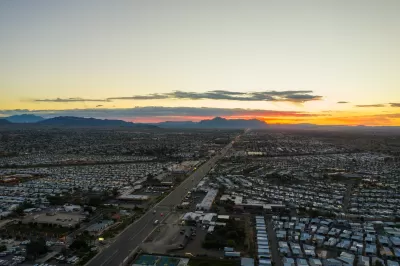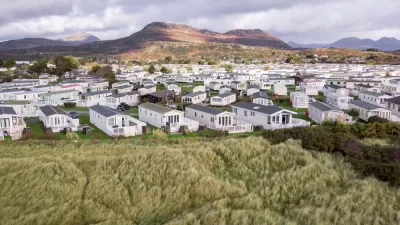Three proposed bills would increase flexibility in zoning and encourage affordable housing production, particularly near light rail.

In a commentary piece in the Arizona Mirror, Christian Solorio and Vicente J. Reid call on policymakers to change zoning laws to prevent the eviction of mobile home residents, many of whom are losing their homes to steep land rent increases and redevelopment.
For decades, the authors write, new mobile home parks have been systematically excluded from many Arizona cities by exclusionary zoning codes. Now, developers are eyeing mobile home parks as affordable, convenient infill development investments for multifamily apartments or condos, putting residents of manufactured home parks even more at risk of losing their housing.
The authors insist that this displacement of mobile home residents, often fixed-income retirees or other vulnerable groups, should be addressed at the policy level. “Exclusionary zoning practices must end in order to provide our families and communities the security and dignity that is taken with their eviction, displacement, and destruction of their homes.”
Three zoning bills in the Arizona state legislature—House Bill 2536, Senate Bill 1161, and SB 1163—could make an impact on exclusionary zoning. “Each seeks to unwind exclusionary zoning by: allowing for the construction of casitas, manufactured housing, and affordable housing along the light rail by-right.” For the authors, passing these bills is “absolutely necessary to give our working families a fighting chance against increasing housing costs and provide stability for our mobile-home park residents.”
FULL STORY: The eviction of mobile home residents happened by design. Zoning reform can prevent it.

Alabama: Trump Terminates Settlements for Black Communities Harmed By Raw Sewage
Trump deemed the landmark civil rights agreement “illegal DEI and environmental justice policy.”

Study: Maui’s Plan to Convert Vacation Rentals to Long-Term Housing Could Cause Nearly $1 Billion Economic Loss
The plan would reduce visitor accommodation by 25% resulting in 1,900 jobs lost.

Why Should We Subsidize Public Transportation?
Many public transit agencies face financial stress due to rising costs, declining fare revenue, and declining subsidies. Transit advocates must provide a strong business case for increasing public transit funding.

Paris Bike Boom Leads to Steep Drop in Air Pollution
The French city’s air quality has improved dramatically in the past 20 years, coinciding with a growth in cycling.

Why Housing Costs More to Build in California Than in Texas
Hard costs like labor and materials combined with ‘soft’ costs such as permitting make building in the San Francisco Bay Area almost three times as costly as in Texas cities.

San Diego County Sees a Rise in Urban Coyotes
San Diego County experiences a rise in urban coyotes, as sightings become prevalent throughout its urban neighbourhoods and surrounding areas.
Urban Design for Planners 1: Software Tools
This six-course series explores essential urban design concepts using open source software and equips planners with the tools they need to participate fully in the urban design process.
Planning for Universal Design
Learn the tools for implementing Universal Design in planning regulations.
Smith Gee Studio
Alamo Area Metropolitan Planning Organization
City of Santa Clarita
Institute for Housing and Urban Development Studies (IHS)
City of Grandview
Harvard GSD Executive Education
Toledo-Lucas County Plan Commissions
Salt Lake City
NYU Wagner Graduate School of Public Service





























